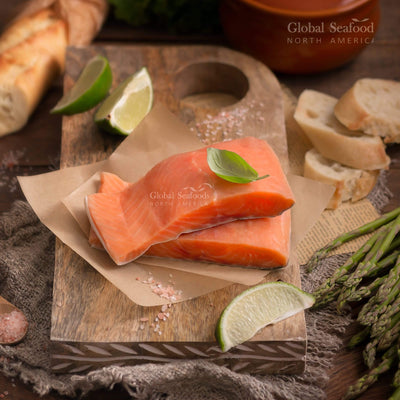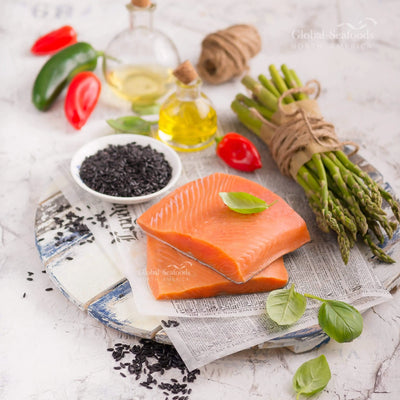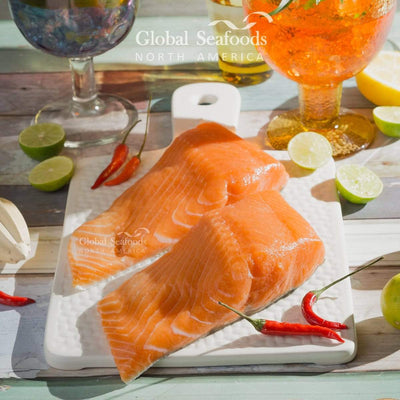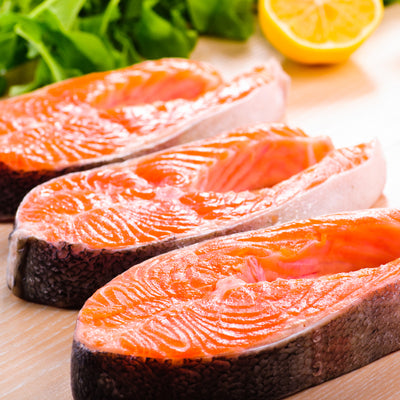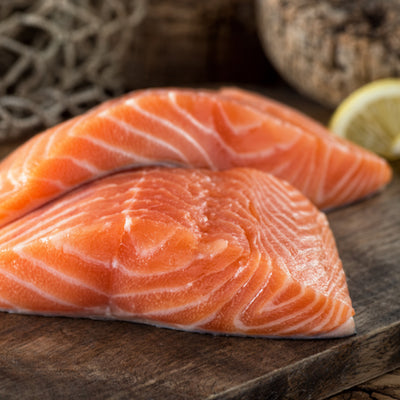Salmón salvaje crudo: riesgos, consejos de seguridad y mejores prácticas

Salmón salvaje crudo: riesgos y precauciones de seguridad
El salmón salvaje crudo es un manjar que se disfruta en todo el mundo , especialmente en sushi, sashimi y poke bowls . Su textura mantecosa y su rico sabor lo convierten en un favorito entre los amantes de los mariscos. Sin embargo, consumir salmón crudo conlleva riesgos , incluidos parásitos e infecciones bacterianas .
Para disfrutar de forma segura del salmón crudo, es fundamental comprender los riesgos y tomar las precauciones adecuadas . Esta guía cubre:
✔️ Parásitos y bacterias comunes encontrados en el salmón crudo .
✔️Síntomas de infección e intoxicación alimentaria .
✔️ Medidas de seguridad para reducir riesgos para la salud .
🔗 Compre salmón salvaje seguro y de alta calidad:
👉 Compre salmón salvaje de calidad para sushi
Riesgo de parásitos en el salmón crudo
1. Parásitos comunes que se encuentran en el salmón crudo
El salmón crudo puede contener parásitos microscópicos que pueden causar infecciones graves si se ingieren . Estos parásitos suelen encontrarse en peces capturados en estado salvaje y pueden no ser visibles a simple vista.
| Parásito | Descripción | Riesgos para la salud |
|---|---|---|
| Anisakis (gusano redondo) | Un gusano parásito encontrado en el pescado crudo | Provoca anisakiasis , que provoca dolor de estómago, náuseas y vómitos. |
| Diphyllobothrium (tenia de los peces) | Puede crecer hasta 30 pies en los intestinos. | Provoca deficiencias de nutrientes, pérdida de peso y problemas digestivos. |
| Nanophyetus salmincola | Se encuentra en el salmón del Pacífico. | Puede transmitir infecciones bacterianas, causando fiebre y diarrea. |
💡 ¿Sabías que? Si utilizas salmón salvaje para consumirlo crudo, DEBE estar congelado para eliminar parásitos y bacterias.
🔗 Compre salmón congelado apto para sushi por seguridad:
👉Compra Salmón Salvaje Congelado Premium
2. Síntomas de infecciones parasitarias
Si consume salmón crudo infectado con parásitos, los síntomas pueden aparecer en cuestión de horas o días e incluyen:
✔️ Dolor de estómago persistente
✔️ Náuseas y vómitos
✔️ Diarrea y distensión abdominal
✔️ Pérdida de peso inesperada
✔️ Fatiga y debilidad
Los casos graves pueden provocar obstrucción intestinal o reacciones alérgicas . Busque atención médica de inmediato si experimenta síntomas persistentes después de comer pescado crudo.
Riesgo de infecciones bacterianas en el salmón crudo
1. Bacterias comunes en el salmón crudo
A diferencia de los parásitos, las bacterias no se destruyen con la congelación . Si el salmón se manipula o almacena de forma inadecuada , las bacterias dañinas pueden multiplicarse y causar intoxicación alimentaria .
| Bacteria | Fuente | Síntomas |
|---|---|---|
| Salmonela | Se encuentra en mariscos contaminados | Fiebre, diarrea, calambres abdominales. |
| Vibrio | Presente en mariscos crudos y agua de mar. | Dolor de estómago intenso, vómitos, deshidratación. |
| Listeria | Crece en mariscos almacenados incorrectamente | Síntomas parecidos a los de la gripe, peligrosos para las embarazadas |
💡 Grupos en riesgo: Las mujeres embarazadas, los niños pequeños, las personas mayores y las personas con sistemas inmunes debilitados deben EVITAR comer salmón crudo debido a los riesgos para la salud.
🔗 Garantice una manipulación segura de los productos del mar con salmón de alta calidad:
👉 Compra salmón salvaje fresco y congelado
2. Síntomas de intoxicación alimentaria bacteriana
✔️ Fiebre y escalofríos
✔️ Diarrea severa y deshidratación.
✔️ Vómitos y náuseas
✔️ Calambres abdominales
La intoxicación alimentaria puede ser mortal si no se trata. Si los síntomas persisten durante más de 48 horas , consulte a un médico de inmediato.
Cómo reducir el riesgo de enfermedades por comer salmón crudo
1. Compre salmón apto para sushi o previamente congelado
✔️ Compre de proveedores de mariscos confiables que sigan estrictas pautas de manipulación.
✔️ Busque etiquetas de calidad para sushi , lo que significa que el pescado ha sido congelado para matar los parásitos .
✔️ Revisa la fecha de caducidad y compra el salmón más fresco posible .
🔗 Compre salmón seguro y apto para sushi:
👉 Compre salmón de alta calidad apto para sushi
2. La congelación profunda mata los parásitos
✔️ Congele el salmón a -4 °F (-20 °C) durante al menos 7 días antes de consumirlo crudo.
✔️ La congelación profunda a -31 °F (-35 °C) durante 15 horas mata los parásitos con mayor eficacia.
✔️ NUNCA coma salmón salvaje recién capturado crudo sin congelarlo primero.
💡 ADVERTENCIA: Incluso congelado, el salmón salvaje NO se recomienda para mujeres embarazadas, niños o personas con sistemas inmunes débiles .
🔗 Pida salmón salvaje congelado para un consumo crudo seguro:
👉 Comprar salmón salvaje ultracongelado
3. Almacenamiento y manipulación adecuados
✔️ Refrigere el salmón crudo a 40 °F (4 °C) o menos .
✔️ Consumir dentro de 1-2 días desde la compra.
✔️ Mantenga el salmón en envases herméticos para evitar la contaminación cruzada.
✔️ Descongele el salmón congelado en el refrigerador , NO a temperatura ambiente.
🔗 Compre salmón salvaje fresco para prepararlo de manera segura en casa:
👉Comprar Salmón Salvaje Fresco Online
4. Cocine el salmón para lograr la máxima seguridad
✔️ Cocine el salmón a una temperatura interna de 145 °F (63 °C) para eliminar las bacterias.
✔️ Sellar o cocinar parcialmente la superficie reduce los riesgos de contaminación.
✔️ El ceviche y el curado (gravlax) NO matan los parásitos , solo la congelación lo hace.
💡 Alternativa más segura: prueba el salmón ahumado en caliente , que está completamente cocido y tiene un delicioso sabor ahumado .
🔗 Pruebe el salmón ahumado seguro y listo para comer:
👉 Comprar Salmón Sockeye Ahumado en Caliente
Preguntas frecuentes sobre el consumo de salmón crudo
P1: ¿Es seguro comer todo el salmón salvaje crudo?
✅ No. Solo el salmón salvaje previamente congelado y apto para sushi es seguro para comer crudo. El salmón salvaje recién capturado debe cocinarse o congelarse primero .
P2: ¿El salmón de piscifactoría tiene parásitos?
✅ El salmón de piscifactoría tiene menos probabilidades de contener parásitos, pero aún puede ser portador de bacterias . Asegúrese siempre de manipularlo y congelarlo correctamente.
P3: ¿Cómo puedo saber si el salmón crudo está fresco?
✅ Busque:
✔️ Pulpa brillante y firme (sin decoloración).
✔️ Un olor suave, parecido al del mar (no demasiado a pescado).
✔️ Sin baba ni exceso de líquido .
P4: ¿Puedo comer salmón crudo si estoy embarazada?
❌ No. Las mujeres embarazadas deben evitar el salmón crudo debido al riesgo de listeria .
Q5: ¿Puede el jugo de limón o el vinagre matar los parásitos?
❌ No. Las preparaciones al estilo ceviche no eliminan los parásitos . La congelación es la única forma de matarlos .
🔗 Compre salmón salvaje seguro y apto para sushi:
👉 Pide Salmón Salvaje Congelado Premium
Conclusión: Disfrute del salmón crudo de forma segura
El salmón salvaje crudo es un manjar delicioso y rico en nutrientes , pero conlleva riesgos . Para disfrutar del salmón crudo de forma segura:
✔️ Elija salmón apto para sushi o previamente congelado .
✔️ Congelar profundamente a -4 °F durante 7 días o más para matar los parásitos .
✔️ Compre de proveedores de mariscos confiables .
✔️ Conservar adecuadamente y consumir en 1-2 días .
✔️ Cocine el salmón a 145 °F para una máxima seguridad .
✔️ Evite el salmón crudo si está embarazada, es un niño o tiene un sistema inmunológico debilitado .
🔗 Disfrute de salmón salvaje seguro y de alta calidad:
👉 Compre salmón fresco y congelado apto para sushi
Para obtener más consejos sobre seguridad y recetas gourmet sobre mariscos , visita Global Seafoods en YouTube .
Ver artículo completo

How to Make Sea Bream Sushi With Dry-Aged Tuna & Crab Roll — Step-by-Step With Chef Joshua
A complete guide to making Sea Bream sushi at home, including filleting, curing, slicing, and building a Dry-Aged Tuna & Crab sushi roll. Chef Joshua shares professional tips for restaurant-quality results.

Cangrejo hervido para la noche de juegos: Todo lo que necesitas para una fiesta de mariscos perfecta
Lleva tu noche de juegos al siguiente nivel con una fiesta de cangrejo hervido. Aprende las mejores recetas, consejos de cocina y trucos para organizar un festín de mariscos inolvidable.

Cangrejo hervido para una cita romántica: una guía para un festín de mariscos perfecto
Haz que tu próxima cita sea inolvidable con una experiencia romántica con cangrejo hervido. Esta guía te lo explica todo, desde el ambiente hasta las mejores variedades de cangrejo.

